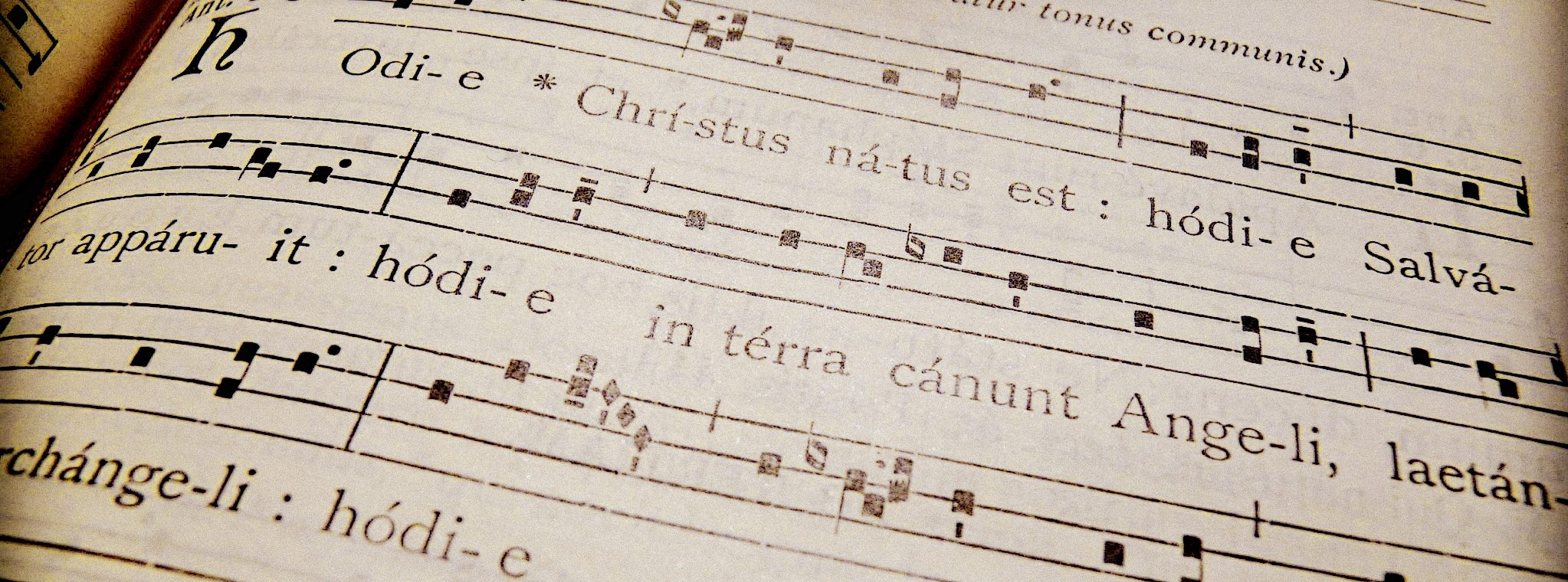Some thoughts on liturgical music
If there is one thing that has a great potential for causing division among Catholics, it is the music of the local parish. Everyone has their own taste and backgrounds. Do you come from a parish with a full choir, decked out in robes, accompanied by an organ masterfully played? Or perhaps a a folk choir with guitar? Maybe you attend a “Life Teen” Mass with electric guitar, bass, and a drum kit. Maybe there is little music at all, beyond what two or three non-musically trained volunteers can put together each week. I’m willing to bet, however, that your home parish doesn’t frequently feature Gregorian chant in their Sunday liturgies. Why is this?
Many think the answer is obvious. Didn’t all that go out with Vatican II and the New Mass? Isn’t it just now starting to make a come-back with the new allowance of the Old Mass (now called the Extraordinary Form) under Benedict XVI?
Well…. not exactly.
The truth is that Vatican II did have something to say about sacred music in the liturgy (more in fact, than any other council before it). But it’s not what the average Catholic might think. Here’s what the Fathers of the Second Vatican Council actually said.
The Church acknowledges Gregorian chant as specially suited to the Roman liturgy; therefore, other things being equal, it should be given pride of place in liturgical services.
Sacrosanctum Concillium, 116
The Vatican II Fathers go on to say that other sacred music is allowed, as long as it is of a sufficiently dignified nature; the document only mentions one other type of music specifically by name, and that is polyphony. Polyphony is a Renaissance style of music combining many voices singing different texts into one unified musical whole (unlike Gregorian chant, where all singers sing with one voice).
So Vatican II did not mandate Gregorian chant (nor did any council previous), but it does give it “pride of place” in the liturgy. “All things being equal,” it says, this is what you should be hearing when you attend Mass.
Now is a good time to introduce you to a book called the Liber Usualis. This volume was the book of Gregorian chant used prior to the New Mass (Novus Ordo). It contained many settings of the ordinary chants of the Mass (those for which the text is the same for each Mass, i.e. the Gloria, Sanctus, Agnus Dei, etc.), as well as the proper chants for the specific Masses of the year. This concept of “propers” is something that has been largely lost. Most modern Catholics are unaware of their significance, let alone their existence. But these are prayers that are particular to each Mass, and there are chants that are associated with them that have developed along with the liturgy for the past 1500 years. So, for example, there will be a proper introit (entrance antiphon) for the 6th Sunday of Ordinary Time, and a proper communion antiphon, etc., particular to that Mass, which relates to the readings and general theme for the Mass. The Liber Usualis had all of that for the entire Church year. It was (is) a massive collection of the musical heritage of the Church. This is what the Vatican II Fathers had in mind when they said “Gregorian chant” should have “pride of place.”
So if Vatican II speaks so highly of Gregorian chant, why don’t we hear it at Mass? Well, as you may know, the Novus Ordo Mass did not come directly from Vatican II. The council called for a renewal and revision of the liturgy, but it did not give us the new Mass. That came later. Did Gregorian chant somehow get left out when the Novus Ordo was issued?
Let’s take a look. The text that the priest follows when he offers the Mass is called the Roman Missal. And the liturgical norms for this liturgy are laid out in the document called the General Instruction of the Roman Missal, often shortened to “GIRM.” In 2001 a new (third) edition of the Roman Missal, as well as it’s Instruction, were promulgated by John Paul II (in Latin). The English translation of the Roman Missal itself is still in the works, but an English translation of the GIRM has long been available. Let’s see what this latest Instruction has to say about music in the liturgy.
All other things being equal, Gregorian chant holds pride of place because it is proper to the Roman Liturgy. Other types of sacred music, in particular
GIRM 41
polyphony, are in no way excluded, provided they correspond to the spirit of the liturgical action and that they foster the participation of all the faithful
Sound familiar? It should. The footnote for this section cites Sacrosanctum Concilium, which we just quoted from. I should add, too, that by “participation of all the faithful” it does not mean that all the faithful should be able to sing along. No, the participation of the faithful at Mass is primarily one of prayer. Music that contributes towards a prayerful spirit among the faithful is aiding their participation. It really matters not whether the congregation can sing along.
There are some parts of the Mass, though, that the congregation is expected to say or sing aloud. In fact, the GIRM makes a point to say:
Since the faithful from different countries come together ever more frequently, it is fitting that they know how to sing together at least some parts of the Ordinary of the Mass in Latin, especially the Creed and the Lord’s Prayer, set to simpler melodies.
GIRM 41
So, when was the last time your parish all chanted the Creed in Latin? Enough said. Now, let’s take a look at some of what the GIRM has to say about music for some other particular parts of Mass.
Starting at the beginning, regarding the Entrance, the GIRM states:
In the dioceses of the United States of America there are four options for the
GIRM 48
Entrance Chant: (1) the antiphon from the Roman Missalor the Psalm from
the Roman Gradual as set to music there or in another musical setting;
(2) the seasonal antiphon and Psalm of the Simple Gradual; (3) a song
from another collection of psalms and antiphons, approved by the Conference of Bishops or the diocesan Bishop, including psalms arranged in responsorial or metrical forms; (4) a suitable liturgical song similarly approved by the Conference of Bishops or the diocesan Bishop.
What does all that mean? Basically, the Church is presenting us with four options for music during this part of Mass. Either the proper antiphon for that Mass according to the official texts of the Church (the Roman Gradual and the Simple Gradual are essentially like the Liber Usualis for the New Mass), or the proper antiphon from another collection with Ecclesial approval (these would be texts such as the Gregorian Missal or the Anglican Use Gradual, the latter of which has all the antiphons in English translation). Barring all this, the fourth and final option is another “suitable liturgical song.”
Now, I don’t know percentages, but I’m willing to bet that in the majority of parishes across the United States, what you will hear on any given Sunday is the fourth option — some hymn as selected by the choir or music director.
And this is, I think, one of the major reasons why we do not hear Gregorian chant, or know anything about “proper antiphons” in our culture today. Given the option not to sing or chant these texts, people have opted not to. And we have sadly lost a major part of our Catholic culture and tradition.
Paragraph 74 of the GIRM says that the Offertory chant follows the same norms as the Entrance chant (i.e. we have the same four options — the last of which is “another suitable song.”).
Paragraph 87 deals with music at Communion, for which (surprise!) we have the same four options. Paragraph 88, however, does allow for “a psalm or other canticle of praise or a hymn” that could be sung by the entire congregation after the communion antiphon. But the first choice, once more, is for the proper antiphon for that particular Mass to be chanted.
In addition to these proper antiphons, there is also the Alleluia antiphon, which is mentioned in paragraph 62. Interestingly enough, no options are given here.
The Alleluia is sung in every season other than Lent. The verses are
GIRM 62
taken from the Lectionary or the Gradual.
Period. No other source for Alleluia verses is given. But, probably because we have gotten so used to exercising our options in the Entrance, Offertory, and Communion music, we have made our own options where they do not exist, such as with the Alleluia verse.
I have, in my own experience, encountered even worse abuses. I have seen many integral prayers of the Mass replaced by “another suitable song” including the Responsorial Psalm, the Gloria, and the Agnus Dei.
The end result, unfortunately, of taking all of these “options” (even those we don’t really have) is chaos. You don’t know what you might encounter when you enter a parish church for the first time as a visitor. Will you be asked to sing from a hymnal filled with old classic Protestant hymns accompanied by an organ? Will you be asked to sing along with a “contemporary choir” using throw-away misselletes or “song sheets”? Or will you maybe, just maybe, get a chance to hear the traditional music of the Church, which is proper to the Roman Rite?
If you were a person whose only experience with Catholic worship was what you have read in the liturgical documents governing the worship of the Church and the documents of the Second Vatican Council, you’d expect to hear a lot of Latin, a lot of Gregorian chant, and to hear the proper antiphons for the Mass most of the time. You might think that you’d hear the occasional other hymn, perhaps after the proper Communion antiphon has been sung, or as a recessional hymn. (Which, by the way, you won’t read about in the GIRM, because it really is not part of the Mass — it occurs after the priest says Ita Missa Est. The Mass is ended!)
You would be very surprised, having read these documents, to discover parish after parish, and even cathedrals, where the music director’s weekly job is to select four or five “other suitable songs” for the Sunday Mass. The proper antiphons are not even considered, if indeed they are even known about!
And I think this is the real key. Most music directors and choir members are well meaning people (in many cases volunteers) who simply do not know what the liturgical documents say, or that the Church has an ideal in mind when it comes to our sacred music, or that things such as “proper antiphons” exist at all. And this is a sad commentary. These documents are all readily available, many of them free on line (I’ve supplied links above in many cases). With today’s information technology, there is really no excuse for those involved in music ministry not to be aware of what the Church expects of us in this regard.
And no, we may not be able to meet this “ideal” in many cases, at least not immediately. But it does present us with something we can strive for, a rule against which we can measure our own efforts.
As for me, personally, the more I learn about sacred music and study the liturgical documents, the less satisfied I become with the current model of “let’s select four hymns for this week.” I long to hear the tones of the proper antiphons, setting the tone (literally) for the Mass itself.
One day, perhaps, the ideal will not be so uncommon.

